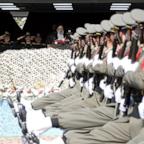Scientists Study Tissue From Old Flu Corpses
Feb. 6, 2004 — -- A 21-year-old Army private took his final breath during the early morning hours in Camp Jackson, S.C.
Two months later, an Inuit woman perished along with nearly all the other adults in her Alaskan village. During that same month, a 50-year-old woman died not long after going to the Royal London Hospital — the same hospital where, early the next year, a 25-year-old London man died two days after checking in.
The four people had little in common except that 86 years ago they all fell victim to one of the deadliest viruses in history — the 1918 Spanish flu, which killed 20-40 million people. Now scientists hope scraps of their remains could help save the world from future scourges like one that could mutate from a bird flu now spreading in Asia.
"There is always the fear that another outbreak like the Spanish Flu can certainly happen again," said Jeffrey Taubenberger of the Armed Forces Institute of Pathology in Washington, who co-authored one of the studies published in this week's Science. "So if we can learn about the worst virus and how it became so infectious, we can hopefully prevent it from happening again."
Finding samples of the long-ago virus proved to be a feat of medical forensics. Taubenberger found a lung sample from the soldier's remains among the dusty shelves of his own lab at the Armed Forces Institute, a program that began collecting tissue samples from fallen soldiers during the Civil War to help advance pathology.
He then requested a search at the Royal London Hospital, which had been collecting similar paraffin-contained samples from civilians for decades. The Alaskan woman's remains, meanwhile, were extracted when a medical researcher was granted permission to dig in the village's mass grave five years ago. The permafrost of the Alaskan village had preserved the woman's infection in a frozen state.
Once each sample reached his lab, Taubenberger extracted the fragile remains of the influenza virus in each and sequenced a protein that codes how the virus penetrates and infects the human cell. Then two teams of microbiologists took the genetic codes and expressed them to re-create the virus' proteins.
Then they studied the protein in three-dimensional form, looking for clues to the virus' origin and what may have made it so deadly.
They found the virus contained hallmarks of both human and bird flu viruses and certain features in this combined version somehow made the virus a killing machine. The researchers found that the virus' lethal bite might have had something to do with its bird flu-like qualities.
"It looked like an avian virus, but it has some human characteristics," said Ian Wilson, a microbiologist at Scripps Research Institute in La Jolla, Calif., who studied the protein's structure and published the results in this week's issue of Science. "So there had to have been some adaptation."
Steve Gamblin at the MRC National Institute for Medical Research in London found, for example, that the site where the virus binds to a cell to infect its host contains traces of the bird virus, but positions its chemical building blocks in a way that lets them interact with human hosts. This adaptation meant people suddenly became vulnerable to a virus that was once exclusive to birds and unfamiliar to their bodies' natural defenses.




